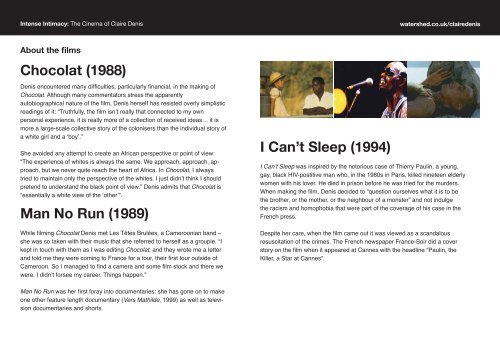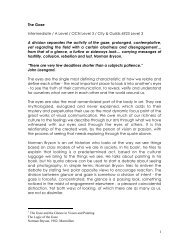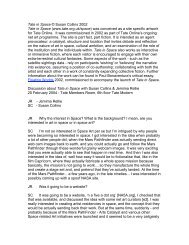Intense Intimacy The Cinema of Claire Denis
Intense Intimacy: The Cinema of Claire Denis - DShed
Intense Intimacy: The Cinema of Claire Denis - DShed
- No tags were found...
Create successful ePaper yourself
Turn your PDF publications into a flip-book with our unique Google optimized e-Paper software.
<strong>Intense</strong> <strong>Intimacy</strong>: <strong>The</strong> <strong>Cinema</strong> <strong>of</strong> <strong>Claire</strong> <strong>Denis</strong><br />
watershed.co.uk/clairedenis<br />
About the lms<br />
Chocolat (1988)<br />
<strong>Denis</strong> encountered many dif culties, particularly nancial, in the making <strong>of</strong><br />
Chocolat. Although many commentators stress the apparently<br />
autobiographical nature <strong>of</strong> the lm, <strong>Denis</strong> herself has resisted overly simplistic<br />
readings <strong>of</strong> it: “Truthfully, the lm isn’t really that connected to my own<br />
personal experience, it is really more <strong>of</strong> a collection <strong>of</strong> received ideas… it is<br />
more a large-scale collective story <strong>of</strong> the colonisers than the individual story <strong>of</strong><br />
a white girl and a ‘boy’.”<br />
She avoided any attempt to create an African perspective or point <strong>of</strong> view:<br />
“<strong>The</strong> experience <strong>of</strong> whites is always the same. We approach, approach, approach,<br />
but we never quite reach the heart <strong>of</strong> Africa. In Chocolat, I always<br />
tried to maintain only the perspective <strong>of</strong> the whites. I just didn’t think I should<br />
pretend to understand the black point <strong>of</strong> view.” <strong>Denis</strong> admits that Chocolat is<br />
“essentially a white view <strong>of</strong> the ‘other’”.<br />
Man No Run (1989)<br />
While lming Chocolat <strong>Denis</strong> met Les Têtes Brulées, a Cameroonian band –<br />
she was so taken with their music that she referred to herself as a groupie. “I<br />
kept in touch with them as I was editing Chocolat, and they wrote me a letter<br />
and told me they were coming to France for a tour, their rst tour outside <strong>of</strong><br />
Cameroon. So I managed to nd a camera and some lm stock and there we<br />
were. I didn’t forsee my career. Things happen.”<br />
I Can’t Sleep (1994)<br />
I Can’t Sleep was inspired by the notorious case <strong>of</strong> Thierry Paulin, a young,<br />
gay, black HIV-postitive man who, in the 1980s in Paris, killed nineteen elderly<br />
women with his lover. He died in prison before he was tried for the murders.<br />
When making the lm, <strong>Denis</strong> decided to “question ourselves what it is to be<br />
the brother, or the mother, or the neighbour <strong>of</strong> a monster” and not indulge<br />
the racism and homophobia that were part <strong>of</strong> the coverage <strong>of</strong> his case in the<br />
French press.<br />
Despite her care, when the lm came out it was viewed as a scandalous<br />
resuscitation <strong>of</strong> the crimes. <strong>The</strong> French newspaper France-Soir did a cover<br />
story on the lm when it appeared at Cannes with the headline “Paulin, the<br />
Killer, a Star at Cannes”.<br />
Man No Run was her rst foray into documentaries: she has gone on to make<br />
one other feature length documentary (Vers Mathilde, 1999) as well as television<br />
documentaries and shorts.




